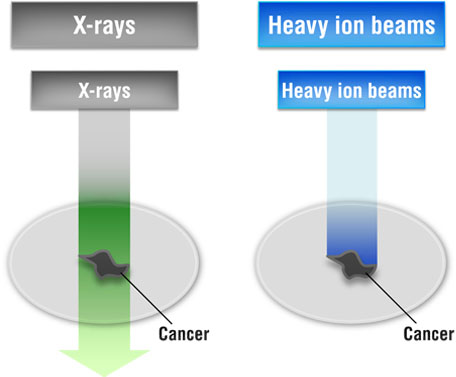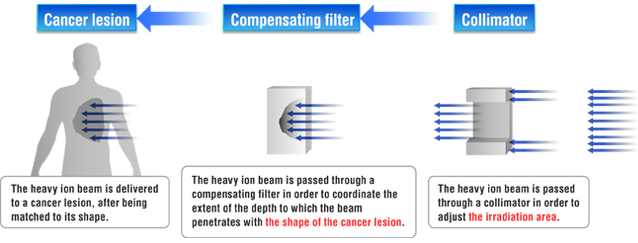
- What is heavy ion radiotherapy?
- Characteristics of heavy ion radiotherapy
Characteristics of heavy ion radiotherapy
Excellent therapeutic effects based on precise irradiation technology
Excellent therapeutic effects on cancers resistant to X-rays and gamma rays
Studies on charged particle therapy have been advanced in order to treat intractable cancers that are resistant to conventional radiations (X-rays and gamma rays). Radiotherapy with protons or fast neutrons has excellent therapeutic effects on some cancers. However, proton radiotherapy is equivalent to X-ray and gamma ray radiotherapy in its ability to kill cancer cells, while fast neutron radiotherapy has the disadvantage of a low dose concentration. Heavy ion (carbon) radiotherapy has more excellent therapeutic effects than fast neutron radiotherapy, and is comparable with proton radiotherapy in the concentration of radiation on diseased areas.
Essential technology for accurately irradiating cancer cells
In the Japanese heavy ion radiotherapy system, horizontal, vertical, 45-degree angle, and other irradiation ports are combined to implement heavy ion radiotherapy.(Previously new superconductive Gantry is used for therapy for patient’s convenience during treatment.) With a heavy ion beam, the dose can be concentrated on a targeted cancer lesion. So as to optimize this strength of the therapy, the vertical and horizontal beams are delivered precisely to a tumor, with their energy coordinated to match the depth of the tumor.
Differences from conventional radiation


Video Clip Presenting Heavy Ion Radiotherapy
Please watch this CG animation of heavy ion radiotherapy.

Collimators and compensating filters essential for precise irradiation
An accelerated beam is enlarged for irradiation to an entire tumor. The beam is shaped with a collimator and a compensating filter and irradiated to the tumor. The collimator determines the beam shape by limiting the horizontal range for irradiation to a cancer lesion only. The compensating filter adjusts the range of the depth to which the beam reaches. For heavy ion radiotherapy, a collimator and a compensating filter are created individually according to the treatment plan data of each patient.
However, scanning irradiation makes these tools unnecessary.
Moreover, in order for the patient to be in the same position during every irradiation session, handcrafted implements, made from a plastic material that changes shape with temperature, are used to fix the position of the body.

High-accuracy stereoscopic diagnostic imaging using four-dimensional X-ray CT scanning
For heavy ion radiotherapy, high-accuracy imaging technology is essential to know exactly where a cancer lesion is. Recently, it has become possible to exactly locate cancer lesions in organs that are moving due to breathing, by means of stereoscopic video imaging using a four-dimensional X-ray CT scanner.
Advanced technology to support improving treatment accuracy
Improving treatment precision and therapeutic efficiency are supported by the research and development of accelerator technology and irradiation techniques, including respiratory-gated irradiation for irradiating a target that is moving due to breathing, and layer-stacking conformal radiotherapy, which uses dynamic device control during irradiation so as to match the treatment volume to the shape of a cancer lesion as much as possible in order to reduce unnecessary doses to the normal tissue near the surface of the body.
[Reference data] National Institutes for Quantum and Radiological Science and Technology, National Institute of Radiological Sciences














